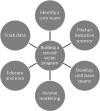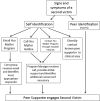Deployment of a Second Victim Peer Support Program: A Replication Study
- PMID: 30229168
- PMCID: PMC6132481
- DOI: 10.1097/pq9.0000000000000031
Deployment of a Second Victim Peer Support Program: A Replication Study
Abstract
Background: The second victim phenomenon occurs when health-care providers experience significant professional distress (compassion dissatisfaction, burnout, secondary traumatic stress) and psychological distress (shame, anxiety, and depression) as a result of medical errors or adverse patient outcomes. Few hospitals have institution-wide systems in place to assist employees through the recovery process.
Methods: At Nationwide Children's Hospital (NCH), a peer-based support program called "YOU Matter" was executed and spread hospital-wide. The program emulated the framework and execution strategy designed by University of Missouri Health Care's (MUHC) "forYOU" Team. Strategic elements of the program's structure were reviewed and adapted for NCH with system-wide deployment and enhancement to include electronic peer support reporting. This article summarizes program implementation, management, and sustainment over the past 2 years.
Results: By following University of Missouri Health Care's model, we successfully deployed an institution-wide second victim program. Since the November 2013 initiation, we have documented 232 peer and 21 group encounters. High-risk clinical areas for second victimization at NCH included the emergency department (ED), pediatric intensive care unit (PICU), cardiothoracic intensive care unit (CTICU), and pharmacy department. Registered nurses (RNs) and licensed practical nurses (LPNs) have had the highest number of encounters necessitating second victim support (32%). Supported staff reported improved emotional state and improved return-to-work metrics.
Conclusions: An organization's culture of patient safety can be enhanced by ensuring staff psychological safety. Programs like "YOU Matter" and the "forYOU" Team are essential building blocks to improve the overall safety culture and quality of care. Implementation of "YOU Matter" at NCH validates the MUHC program and demonstrates its generalizability to other health-care institutions.
Figures







References
-
- Kohn LT, Corrigan J, Donaldson MS. To Err is Human: Building a Safer Health System. 2000Washington, D.C.: National Academy Press. - PubMed
-
- Pham JC, Aswani MS, Rosen M, et al. Reducing medical errors and adverse events. Annu Rev Med. 2012;63:447–463.. - PubMed
-
- Rafter N, Hickey A, Condell S, et al. Adverse events in healthcare: learning from mistakes. QJM. 2015;108:273–277.. - PubMed
-
- Conway J, Federico F, Stewart K, et al. Respectful Management of Serious Clinical Adverse Events. IHI Innovation Series White Paper. 2011. Cambridge, MA: Institute for Healthcare Improvement; Retrieved from Institute for Healthcare Improvement: www.ihi.org/IHI/WhitePapers/. Accessed February 2015.
-
- Brilli RJ, McClead RE, Jr, Crandall WV, et al. A comprehensive patient safety program can significantly reduce preventable harm, associated costs, and hospital mortality. J Pediatr. 2013;163:1638–1645.. - PubMed
LinkOut - more resources
Full Text Sources
Other Literature Sources
Miscellaneous
